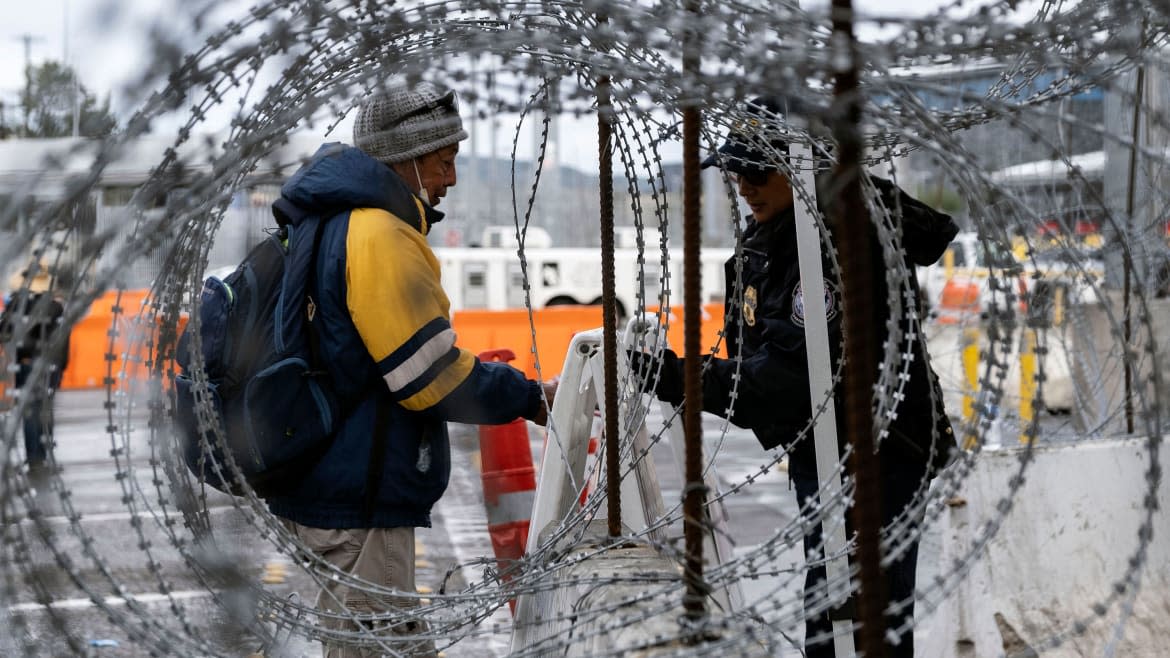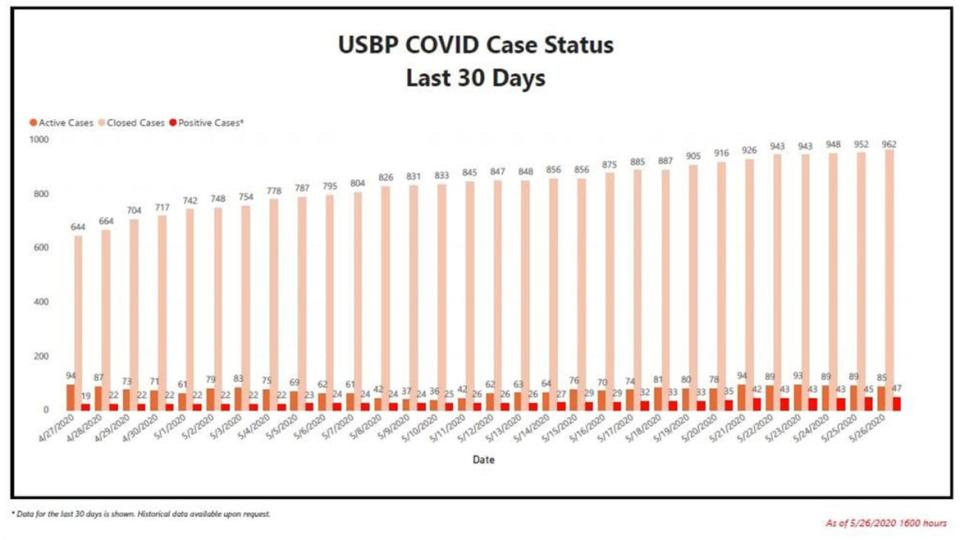Internal Documents Reveal Border Patrol Infections Tripled in Six Weeks

COVID-19 infections in the U.S. Border Patrol—where some agents have reportedly shunned masks—have shot up, according to internal government data obtained exclusively by The Daily Beast.
At the end of April, according to the leaked documents—which are labeled “For Official Use Only/Law Enforcement Sensitive”—there were 19 positive cases of COVID-19 among Border Patrol employees who have been tested for the virus. By May 26, the number of positives jumped to 47, an increase of almost 150 percent. As of June 7, a total of 69 Border Patrol members have tested positive for COVID-19, updated figures reveal.
Of the agency’s 19,648 agents, 556 have been tested.
The uptick comes on the heels of video that showed Border Patrol agents working without face masks and other personal protective equipment (PPE) when interacting with each other, as well as the public. About 12.4 percent of the Border Patrol agents screened for COVID-19 to date have tested positive for the virus that has now killed more than 110,000 Americans, Border Patrol data shows—up from roughly 10 percent one week ago. That figure is double the national average, which is currently between 5 and 6 percent
Approximately 2.8 percent of the overall force has been tested thus far—bringing the numbers roughly in line with the 2.74 percent of the general U.S. population that has been tested.

The number of COVID-19 cases among Border Patrol employees between April 26 and May 26.
Anna Yeung-Cheung, professor of biology at Manhattanville College in Purchase, New York, told The Daily Beast that she is alarmed but “not surprised” by the number of COVID-19 cases among Border Patrol agents.
“If you have someone who deals with the public and you don’t have any protection, this is what happens,” Yeung-Chung said.
Dr. William Haseltine, a noted epidemiologist who chaired the U.S.-China Health Summit in Wuhan, China, last year, said, “All frontline law enforcement is at risk. Many Border Patrol agents are going around getting infected, infecting their families, and infecting each other.”
“In any area where there’s a high incidence rate of new infections, as there are in Texas and Southern California, law enforcement agents are very likely to encounter infected people—and all of them should be tested on a regular basis,” Haseltine told The Daily Beast. “Testing [472 people] is way too low. China tested, in Wuhan, six-and-a-half million people in five or six days. The fact that we’re doing what we’re doing is pathetic. It’s a joke and it’s pathetic and tragic all at the same time to say we are anywhere near where we should be.”
Haseltine also suspects the 10 percent positive rate among agents who have been tested could also be misleadingly low because it is not a representative sample and doesn’t include those without symptoms. In New York City, he points out, about 20 percent of the police force was out sick during April with thousands of cops testing positive.

The American Federation of Government Employees, which represents 700,000 federal workers, has criticized Washington for not testing its members widely enough. After refusing to let officers wear face masks on duty, Customs and Border Protection, the Border Patrol’s parent agency, is reportedly providing officers with one face mask per shift, which union leaders say is inadequate and puts officers at risk. When the federal prison system reportedly refused to test staff for COVID-19 at its 122 facilities, the union set up its own testing apparatus and 30 onsite beds for officers who feared going home and infecting their families. In the absence of widespread testing by the Department of Homeland Security, at least one Border Patrol local has arranged for its members to get tested at a nearby hospital. The cost of the test, including any copay, is covered by insurance.
Art Del Cueto, the head of the national Border Patrol union, declined to comment, citing a busy schedule. A CBP spokesperson said that all CBP and Border Patrol employees have access to an online COVID-19 information portal that includes, among other things, frequent video updates from the agency’s senior medical advisor. Those who can’t telework, like frontline agents and officers, “have ready access” to PPE, according to the CBP representative, who said specific COVID-19 cleaning guidelines are now being issued to all facilities.
“All employees at facilities where an exposure has occurred are notified at the earliest opportunity,” the CBP spokesperson said. “Employees who have been in direct contact with a colleague who has tested positive for COVID-19 are provided with guidance based on the specific risks associated with the exposure.”
The Border Patrol report obtained by The Daily Beast contains examples of the tracking and testing procedure. In one instance, an agent with COVID-19 symptoms on May 10 tested negative on May 12. But the symptoms persisted, and a second test on May 14 came back positive. The agent—who may have been infectious for days—was quarantined for two weeks, according to the report. Another agent had contact with a family member with COVID-19 on May 2, and got a test five days later. A week after that, the results came back negative. But after the onset of flu-like symptoms that same evening, the agent was instructed to self-isolate and get tested again. Two weeks later, the subsequent test came back positive.
Others who tested positive for COVID-19 include a Border Patrol agent who took a Carnival cruise in early March, an agent who stood outside behind another agent who later tested positive for COVID, and a contractor working on the border wall.
Jenn Budd, a former Border Patrol agent who now works as an immigration advocate, says she’s not surprised that agents aren’t wearing PPE even though it is now required.
“Border Patrol agents are predominantly listening to Fox News, [so] most of them don’t think this is going to affect them,” Budd told The Daily Beast. “They think it’ll affect black and brown people. And even though a lot of agents are brown, they don’t see themselves that way... They’re only getting tested when they get sick and [supervision] tells them to go see their doctor and get tested.”
To date, a total of 401 CBP members, which includes Border Patrol agents, have tested positive for COVID-19. Five have died. One of them, CBP officer Omar Emiliano Palmer, a 17-year veteran who worked in passenger operations at New York City’s John F. Kennedy International Airport, began quarantining on April 1 after being exposed to a co-worker who tested positive for the virus. Palmer became symptomatic the next day, and was in the ICU on April 6. He died less than a month later.
One of Palmer’s family members, who asked not to be identified, said Palmer told her that officers had access to sufficient amounts of PPE. As far as providing grief support and assistance with funeral arrangements, CBP has been “amazing,” she told The Daily Beast.
Others, however, are struggling.
“My husband died with no mortgage or life insurance for me and my eleven year old daughter, Megan,” says a GoFundMe page set up by Genevieve McCoy, the wife of late CBP officer Richard McCoy, who died May 3. “We can not pay for the house with just his social security money. We are in need of money just to live and pay expenses. Richard died in the line of duty. He fought for 39 days on a ventilator until his heart gave out. He caught Covid 19 while performing his duties at work. Richard was a Customs and Border Patrol Agent working at Fort Lauderdale, Executive Airport.”
Genevieve McCoy declined to comment.
According to the documents, the top three Border Patrol sectors for COVID-19 exposures are San Diego; El Centro, California; and El Paso, Texas. These are among the most active points along the southern border, with thousands of daily interactions between agents and the public.
“The CBP Senior Medical Advisor and Occupational Safety and Health team established robust procedures and guidance for supervisors and personnel to assess risk from potential COVID-19 exposure, recommend actions and ensure mission continuity during this complex, novel and evolving pandemic,” said the CBP spokesperson. “CBP is taking every available precaution to minimize the risk of exposure to our workforce and to members of the public with whom we interact.”
Get our top stories in your inbox every day. Sign up now!
Daily Beast Membership: Beast Inside goes deeper on the stories that matter to you. Learn more.

 Yahoo News
Yahoo News 
